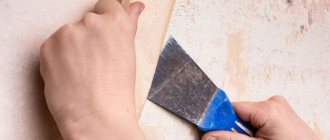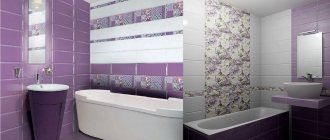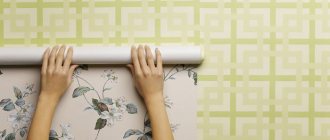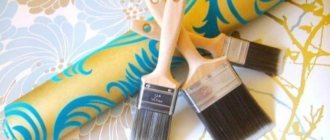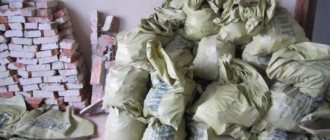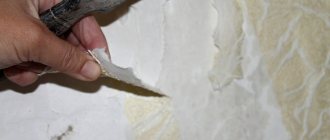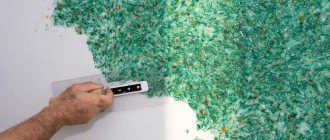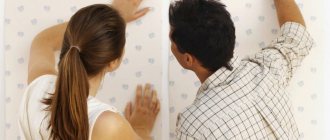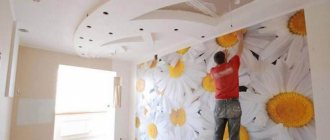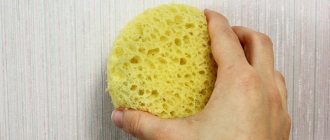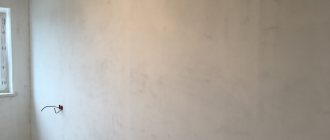In the modern world, difficulties arise more and more often in preparing the surface for wallpapering. And many people ask this question only before the withdrawal process. It turns out that this is not as simple as it seems. In this article, we have prepared 7 tips for you that will definitely be useful to you and you will cope with this task without difficulty.
Why remove old wallpaper?
Surely you know or have heard that previously wallpaper was glued directly on top of the old ones. And that was okay. It never occurred to anyone that they needed to be removed. And most importantly, the result of gluing the new wallpaper was excellent. No swelling, bubbles, or unevenness. Everything was perfect. The secret lies in the wallpaper material used. Previously they were paper. This is acceptable for them. If you are also planning to glue paper wallpaper onto the same coating, which is in good condition, close the article. You can do without removing the old coating.
And if you're planning on applying a different material or coating, keep reading. The old coating will swell or begin to react chemically with the new modern material. The result will not please you. You will lose time, nerves and money spent on materials.
A little advice for “working at heights”
In Soviet times, very often, in order to save money and not have to paint the ceiling, it was also covered with wallpaper. Now this has been replaced by suspended ceilings. But before installing it, and also if you decide to paint and cover the ceiling with stucco, then the old coating will also need to be removed. It is very inconvenient to do this, since the work takes place on a stepladder, the head is in an unnatural position. Which makes the task very difficult. To make it easier for you, you can use a needle roller with a long handle. They can be used to hook corners and easily remove old wallpaper. Then remove any remaining glue and loose pieces.
Preparing to remove old coating
Removing old coating is not the most pleasant process. Also very dirty. Therefore, it is necessary to prepare the room for such loads.
- Remove all large furniture
- Collect all remaining items in the center of the room and cover with a special protective film.
- Lay the same film material on the floor and add paper or newspapers on top to prevent slipping
- Protect the baseboard with film and masking tape
- Turn off all sources of electricity if high humidity is expected.
- At the entrance to the room, lay textiles soaked in water. This will prevent dirt from spreading between rooms.
- Prepare all necessary materials
What to do if you soak the wallpaper, but it still won’t come off?
If, after soaking, the wallpaper cannot be torn off by hand or cleaned with a spatula, it means that the glue has compacted too much and it is necessary to slightly change the moistening process.
- We protect the floor from water - with rags, rags, polyethylene;
- Prepare a plastic film the size of the area of the wall that we are going to clean;
- Prepare a solution based on water with soap and alkali (about 5 g per liter);
- Apply with a roller to the wallpaper and cover with film for four to five hours.
Be sure to use gloves as you work with alkali!!!
As a rule, after this method, you can easily remove even tightly-fitting wallpaper from the wall.
If you are removing wallpaper from concrete walls, then do not forget that it is necessary to remove not only the paper layer, but also the glue itself, this is especially important if painting is planned in the future. To do this, you should treat the walls with a special solution and then wash them. Then the glue will probably not remain on the wall.
Removing old wallpaper without tools
This method is suitable for those whose old wallpaper just begs to be picked up. Namely, they fall off in the ceiling and floor area. In order to remove them, simply pull and the entire canvas will calmly move away from the wall. In some places, difficulties may arise and it will not be possible to remove them so easily. Use a spatula or knife. If this does not help, read the following points.
Other options
One option is to use a vinegar solution on the wallpaper.
Mix vinegar with warm water (1:1), pour the solution into a spray bottle (it’s easy to find - any cleaning product has a spray bottle). If a sprayer doesn't work for you, a paint roller will do the same job.
Apply the solution to the wallpaper until it is sufficiently damp for 30 minutes. Then remove them. If the coating does not come off, re-wet it with liquid, leave it on and repeat the process.
During the entire wall cleaning procedure, place the spray bottle in a pan of hot water. If the water is warm, the result will be more effective.
Important! To avoid damaging the floor, be sure to place newspapers or film on it to stop water from flowing down.
Removing old wallpaper using water
Timeless classic. Our grandmothers also knew this method. And it works. In addition, this option will have much less dust. Just don’t forget to turn off the power to the sockets; you won’t need a short circuit.
Removal process:
- Preparing the room for working with water
- Pour warm water and add a little soap or dish soap.
- Using a damp or even wet cloth, apply the “composition” to the walls.
- Wait 20-30 minutes
- Using a spatula, pry up the layers of wallpaper. Now they can be easily removed.
For an advanced level: go over the wall with a needle roller. This will allow the soapy water to penetrate deeper. The removal process will become faster and more comfortable.
Some areas will still be defended. In this case, a scraper will come in handy.
Tip: immediately put the removed wallpaper into bags. This will save you time and effort after the work is done.
This method is suitable for covering with paper wallpaper. For other materials, read on.
What surface peels off wallpaper better?
If the top layers of the canvases are held on a paper backing, when the surface is saturated, moisture enters the base and they fall off on their own. Such an easy scenario is possible when the concrete surface of the partitions in the apartment is smooth and low-porous, covered with primer and putty, painted with water-based emulsion or other paint.
Over time, cracks and chips may appear in the wall. You can tear off the paper covering from deformed areas without any effort. On concrete walls whitened with bleach, the canvases fall off on their own.
Removing old wallpaper using a special liquid
Suitable for those who don’t want to waste their time on the water method. There are special products that are also applied to the wall. They are inexpensive, and their effect is faster. Just don't expect a miracle. You definitely won't be able to do it in 3 minutes. This method is not much faster than the previous one.
Operating procedure:
- The purchased product is prepared for application to the wall, following the instructions on the package.
- Apply to the wall and leave for about 3 hours (everything is written in the instructions).
- After this, simply and easily remove the old coating.
It sounds nice, but in reality there are nuances. This product is not always applied in the required quantity. In this regard, after removing the wallpaper using this product, they return to the method with soapy water.
This method is suitable for all modern types of wallpaper.
Required Tools
Dismantling the old decorative coating involves the use of tools and devices. Thanks to their presence, the procedure for performing work is significantly simplified. Typically used to remove wallpaper:
- Sharp spatulas of different sizes. You will need at least two pieces;
- Water;
- Capacity;
- Detergent;
- Roller;
- Sponges of different hardness;
- Rags;
- Needle roller for perforating decorative coatings;
- Garbage bags of appropriate size;
- gloves;
- ladder or stepladder;
- knife;
- perforation roller.
The above list is indicative. Often it is supplemented or decreased depending on the chosen direction.
Removing Vinyl Wallpaper
This type of wallpaper consists of PVC film, which is glued to a paper backing. Methods with water and a special liquid are suitable for removing such material.
Let's consider several nuances of such wallpapers:
- Vinyl wallpaper is moisture resistant. In order for water to penetrate into the layer we need, it is necessary to break the integrity of the coating. This is done with a needle roller, knife, or spatula. Choose any of these options.
- Vinyl wallpaper, consisting of several layers, is less easily removed. Craftsmen advise adding glue to the soap solution. The resulting composition becomes thick and lasts longer in the epicenter of the paper layer.
- Use the steaming method. If you have a steam generator or regular steamer, just turn it on and point it at the wallpaper. Under the influence of hot steam, the material can be dismantled without difficulty.
The nuances of cleaning drywall
If the wallpaper was pasted on a wall covered with plasterboard, it is necessary to take into account the peculiarities of the material that was used for leveling. The process of removing the old coating must take into account exactly how the coating was applied.
There are 2 options:
- for putty;
- directly onto the drywall.
If putty was used, then the wallpaper can be removed using almost any of the above methods, and even using solvents. There shouldn't be any problems.
If preliminary preparation of the walls has not been carried out, it may be almost impossible to remove old panels without damaging the drywall. In this case, sanding will be required. After this, the surface is primed and new wallpaper is glued.
Drywall consists of cardboard sheets and gypsum, so the paper base should not be allowed to become significantly wet .
Removing old wallpaper glued with PVA glue
PVA does not dissolve in water. Therefore, there are difficulties in removing such a coating. Add soap or vinegar to the water and the removal process will be easier.
A sander and spatula are also used. This is a guaranteed method. Using a spatula, find elements that will remove themselves. Everything else is removed by sanding.
Glass wallpaper
There is such an unusual type of coating - glass wallpaper. They are made from glass fibers of different thicknesses and densities with special impregnation; their structure resembles fiberglass fabric.
They are removed from the wall in the same way as vinyl ones, since they have a very dense structure and come off as a single piece.
If you are removing wallpaper from drywall, it is not advisable to use a liquid - water or a specialized product - since the top layer of drywall is paper and it can get wet. It is best to use special compounds that dissolve glue - their water content is minimal.
When not to touch
In very rare cases, the old layer is still left on the walls.
This happens when it is made with simple Soviet wallpaper and lies (attention!) perfectly flat. And at the same time, the new coating is also paper. In any other case, the old wallpaper must be dismantled.
Useful tips
Some useful tips on how to properly remove wallpaper from the walls quickly, easily and efficiently, and prepare the room for a new renovation: You cannot paste old wallpaper onto new ones. Relief, the darker color of the old coating can appear through the new wallpaper. In addition, the loose parts of the previous layer will not allow the new wallpaper to adhere well. Wallpaper should be steamed from bottom to top. The steam rising will make the glue steaming process faster.
It is better to soak the wallpaper starting from the top. In the same order, you need to start peeling off the paper layer. Turn on the electricity only after the walls with new wallpaper are completely dry. When treating the ceiling, you must protect your eyes with glasses and cover your hair with a scarf or baseball cap. When working with a steamer, you must take care to protect your hands, body, and face, and also ventilate the room after work. If you cannot remove the old coating with water, then experts recommend using wallpaper glue. The concentration of the solution should be made thicker than usual. It should be 20-30% richer.
The glue evenly permeates the paper layer, after which it comes off without much difficulty. After removing the paper covering, it is necessary to treat the walls with an antiseptic composition, a remedy for mold and mildew. This measure will prevent an unpleasant problem from occurring after the repair. After cleaning the old coating, the walls need to be prepared for new repairs. To do this, first apply the primer with a roller. If there are unevenness, holes and differences on the walls, then after priming it is necessary to plaster the walls. For small defects, it is enough to putty them. The last stage is re-priming. Removing wallpaper from walls is a labor-intensive process. But, knowing some of the nuances of working with old coatings, the work can be carried out much more efficiently. There are many ways to remove wallpaper. It is necessary to study them all and choose one that is most suitable for a certain type of wall and wallpaper.
Removing vinyl covering
Vinyl wallpaper, or so-called washable wallpaper, has two layers. The first layer (base) provides reliable adhesion to the wall. It can be made of paper or non-woven fabric. The second gives the canvas decorative and moisture-resistant properties. To remove such wallpaper, it is absolutely not necessary to remove two layers at once. It is enough to remove the second layer, provided that the base is securely glued to the wall. If you need to remove the first layer, then first remove the outer part and soak the base with water. After waiting 15 minutes, vinyl wallpaper can be easily removed with a spatula or wire brush.
Spatula and sander
You will have to resort to them if the wallpaper “sits” on PVA glue. Use a spatula to pry up the pieces that are not glued very well, while the rest are removed using a power tool. After this type of cleaning, it will likely be necessary to level the base.
You should preferably use a spatula when cleaning wallpaper from wooden surfaces. After all, water or steam has a detrimental effect on wood.
If you have to clean liquid wallpaper, then the coating is first moistened generously with water, and after swelling, the mass is removed with the same spatula. By the way, if the removed material is clean, it can be used again.
Other ways to remove wallpaper
If using standard methods the wallpaper still remains in place, you can try steaming the surface with an iron. This method is good for joining using PVA glue or Bustilat. To do this, take a piece of cotton fabric and heat the surface of the wall covering with an iron. After heating, remove them with a utility knife.
If the steaming method did not give the desired results, remove the wallpaper with coarse sandpaper or a vibrator. Cover the remaining unevenness on the wall with plaster or plaster.
Each type of wallpaper requires a special approach. For example, a spatula is best suited for removing moisture-resistant wallpaper. Paper ones are easily removed with water, but for the old, Soviet coating, you need to use chemicals. Also, the removal method is determined by the wall surface and the adhesive material. For example, with a moisture-resistant, plastered wall, wallpaper can be removed much easier than with plasterboard.
Getting rid of liquid wallpaper
Liquid wallpaper is glued to the wall without the use of additional glue. Therefore, to remove such wallpaper, it is best to soak the canvas with hot water. You can use a roller, sponge or spray. You need to wet it several times until the material swells. After this, carefully clean them with a scraper or wire brush. It is worth noting that the resulting mass can be reused by soaking it in water.
To shoot or not to shoot.
Most people don’t bother with this at all, but glue new canvases directly onto the old wallpaper, which absolutely should not be done.
Firstly, if you have old wallpaper or the slightest fragments of it, the wall surface will never be ideal. In other words, immediately after pasting the new wallpaper, as they say, all the bumps and bumps will be visible.
Secondly, the old wallpaper can come off at the most inopportune moment along with the new ones - and all your work will go down the drain.
Thirdly, harmful bacteria and mold fungi often form under old wallpaper, which should be gotten rid of, and this is an additional hassle.
Wetting
Best suited for paper wallpaper.
- In this case, water and a sponge are usually used. After wetting, the wallpaper and glue soften, and the coating can be easily removed: pry it off with a spatula and pull it towards you. It is advisable to wet and remove wallpaper in parts. By the way, the coating comes off most easily on the “seam” side.
- If it is difficult to clean, the area should be moistened again; You may have to use a scraper.
- For wetting, you can also use a roller, rags, or spray bottle. Water should not be applied in excess: it should not flood switches and sockets and drain onto the floor. You need to start from the top.
The good thing about this method is that it is hygienic and dust-free.
Washing and steaming - dealing with difficult wallpaper
Modern manufacturers have come up with means that make it easy to remove old wallpaper - chemical removers. Among the well-known brands on the market, QUELYD DISSOUCOL, Zinsser, ATLAS ALPAN are popular. They penetrate deeply into the structure of the wallpaper and destroy the adhesive layer. Applying the remover does not cause any difficulties. We dilute the composition according to the manufacturer's recommendations, distribute the liquid evenly with a sponge or through a spray bottle. After the finish has swollen, it can be easily removed along with all the remains from the wall.
Chemicals penetrate the structure and destroy the adhesive layer
Another effective option for dealing with difficult wallpaper is steaming. For these purposes, you can use a steam mop or steam cleaner, and if you don’t have them at hand, a regular iron and a wet cloth will do. Turn on the steam mode, place a wet cloth against the problem area of the wall and direct steam from the iron through it. Under the influence of steam, the glue will collapse, and you can quickly tear off the old wallpaper from the walls. Just need to do this while they are still hot. We clean off the small pieces remaining after steaming with sandpaper, a metal scraper or a grinding machine.
Radical method of removal
If you need to tear off material from the walls or ceiling that is glued very tightly, for example, preserved from Soviet times, you may encounter serious difficulties. Previously, during repairs, carpenter's glue, bustilate, and PVA were used, which are capable of gluing wallpaper to the wall for centuries and are completely resistant to ordinary soaking.
A drill with a brush attachment will help, with which the coating can simply be mechanically removed from the wall. This method has a drawback: a stiff brush will remove not only wallpaper from the walls, but also a layer of putty, and possibly pieces of plaster.
Water and soap
In the case when just water does not work very actively, liquid or laundry soap, or any other detergent, including for dishes, is added to it.
Or fabric softener - if the wallpaper is waterproof (300 milliliters of product per bucket of water).
- Laundry soap is first grated (a piece), pour in 4 liters of water and bring to a boil.
- To clean waterproof wallpaper, the surface layer is first perforated and then wetted.
Another option, which experts believe is more effective than simply soaking with water, is the use of wallpaper glue. It is made thicker than usual: twenty to thirty percent. When the paper layer is impregnated with the solution, it comes off easily.
The “wedge by wedge” method is most suitable for removing wallpaper from drywall. Inexpensive glue is diluted according to the instructions, spread on the surface, and after about half an hour, the wallpaper is picked up with a spatula and removed.
The "Mole" method
Pipe cleaner is also used in practice. It is suitable for stubborn coatings. Gloves should be used and the product should be used with caution.
The solution is made in a 1:2 ratio (product to water), stir well. It is applied to the material carefully, with a roller. After five to ten minutes of getting wet, the wallpaper will come off entirely when removed.
